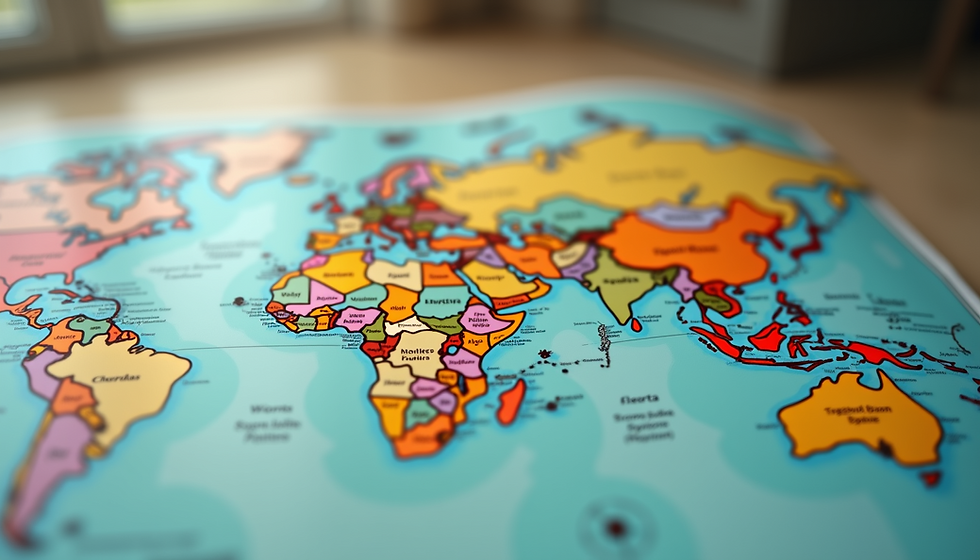Jungle Trekking 101: Essential tips for a Safe and Thrilling Adventure. Sumatra
- The Anxious Passport
- Dec 23, 2024
- 5 min read

1. Plan and Prepare
Researching the Trek:
Know the season: Wet or dry seasons dramatically affect jungle conditions. During the wet season, trails can become muddy and slippery, while in the dry season, water sources may be scarce.
Check local wildlife warnings: Some areas may have snakes, leopards, or even aggressive insects, and knowing how to avoid encounters is crucial.
Maps and apps: Download offline maps or trekking apps like AllTrails or Maps.me before heading out.
Hiring a Guide:
A guide is invaluable for navigating trails, identifying plants and animals, and even sharing cultural knowledge. They also increase your safety by knowing what to do in emergencies.
A guide is required in the Gunung Leuser National Park, as it is a dense Jungle with many opportunities to get lost.
2. Dressing Smart
Moisture-Wicking Fabrics:
Avoid cotton, as it retains moisture and can cause chafing or discomfort. Opt for polyester or merino wool.
Boots:
Break in your boots before the trek to prevent blisters. Make sure they have a solid grip and ankle support for uneven terrain.
Accessories:
A wide-brimmed hat with a strap can protect you from both sun and unexpected rain.
3. Packing Essentials
Bug Repellent:
In jungles with malaria or dengue risks, use a strong repellent like one containing DEET or Picaridin. Natural alternatives include citronella-based sprays, though they may require frequent reapplication.
First Aid Kit:
Include antihistamines for bites, bandages for cuts or blisters, and antiseptic wipes. In jungle environments, even small wounds can quickly become infected.
Water and Purification Tablets:
While carrying water bottles or a hydration bladder is essential, purification tablets or a lightweight filtration system like a LifeStraw ensures you can drink from natural sources if needed.
4. Staying Safe
Stick to the Trail:
Use trail markers, and avoid shortcuts or unmarked paths that can lead to getting lost.
Wildlife Awareness:
Know how to react: For snakes, stay still and back away slowly; for large mammals, avoid eye contact and don’t run. Learn what wildlife is in the area before your trek.
Leeches:
Leeches thrive in wet, tropical jungles. Wear leech socks over your regular socks and boots. If a leech attaches, use salt or a flame to remove it safely without damaging your skin.
5. Hygiene on the Trail
Biodegradable Wipes and Hand Sanitizer:
Keep these accessible to maintain hygiene after meals or bathroom breaks.
Menstrual Care:
Menstrual cups are compact, reusable, and easy to clean in remote areas, making them ideal for jungle trekking. For extra comfort, pack a small bottle of water for rinsing.
6. Respecting the Environment
Waste Management:
Carry out all non-biodegradable trash in a sealed bag. Avoid leaving food scraps, as they can attract wildlife to human trails.
Engaging Locals:
Ask local guides about their traditions and knowledge. Many communities have centuries-old wisdom about the jungle that can enrich your experience.
7. Mental and Physical Readiness
Training Tips:
Practice carrying a loaded backpack on short hikes to get accustomed to the weight.
Incorporate endurance exercises like stair climbing or trail running to prepare for steep inclines.
Mental Toughness:
Jungle trekking can be uncomfortable, from high humidity to unexpected rain showers. A positive mindset and adaptability go a long way in making the trek enjoyable.
Bonus Tip: Night Safety
Jungles can get dark quickly. Always carry a headlamp with extra batteries, and avoid trekking after sunset unless guided by a professional. The sounds of the jungle at night are mesmerizing but can also be disorienting.
Sumatra Jungle Trekking Packing Checklist & Itinerary
Packing Checklist for Jungle Trekking in Sumatra
1. Clothing
Lightweight, Moisture-Wicking Layers: Quick-drying T-shirts and hiking pants.
Long-Sleeved Shirt and Pants: Essential for protection against mosquitoes and leeches.
Waterproof Jacket or Poncho: Sudden rain is common in the Sumatran jungle.
Hiking Boots: Sturdy, waterproof boots with good grip for slippery terrain.
Leech Socks: A must-have for trekking in damp, forested areas.
Hat and Sunglasses: Protect against the sun when crossing open areas.
Swimsuit: For river crossings or refreshing swims.
Extra Clothes: At least one spare outfit to change into after trekking.
2. Gear and Essentials
Backpack (20–30L): Comfortable, lightweight, and water-resistant.
Hydration System: Water bottles or a hydration bladder (2–3L capacity).
Water Purification Tablets or Filter: To purify water from streams or rivers.
Trekking Poles: Helpful for steep or muddy sections.
Headlamp with Extra Batteries: Essential for night trekking or campsite use.
Multi-Tool or Knife: For basic survival tasks.
Dry Bags: Protect your clothes, electronics, and documents.
3. Toiletries and Hygiene
Bug Repellent: DEET-based or natural options (mosquitoes in Sumatra can carry diseases).
Sunscreen: High SPF for UV protection.
First Aid Kit: Include antiseptic, bandages, painkillers, and antihistamines.
Biodegradable Wipes: For personal hygiene.
Toilet Paper and Small Trowel: For outdoor bathroom breaks.
Hand Sanitizer: Keep your hands clean on the trail.
4. Food and Snacks
High-Energy Snacks: Trail mix, granola bars, dried fruits, and nuts.
Electrolyte Powder or Tablets: Replenish minerals lost through sweat.
5. Optional Items
Binoculars: Spotting orangutans or gibbons.
Camera/GoPro: Capture the incredible wildlife and landscapes.
Notebook and Pen: Document your jungle experience.
Portable Charger: Ensure your devices stay powered.
3-Day Jungle Trekking Itinerary: Sumatra
Day 1: Arrival in Bukit Lawang
Morning: Arrive at Bukit Lawang, the gateway to Gunung Leuser National Park.
Afternoon: Meet your guide for a briefing, prepare gear, and explore the village.
Evening: Relax by the river and enjoy local cuisine. Stay overnight in a lodge.
Day 2: Enter the Jungle
Morning: Begin your trek into Gunung Leuser National Park. The trek starts with spotting wildlife such as orangutans, Thomas leaf monkeys, and hornbills.
Afternoon: Break for a packed lunch near a waterfall or river. Swim to cool off if conditions allow.
Evening: Set up camp in the jungle. Enjoy a simple meal cooked by your guide and listen to the jungle’s nighttime symphony.
Day 3: Wildlife and Return
Morning: Wake early to catch the best wildlife activity. Trek deeper into the jungle to spot gibbons, sun bears, or the elusive Sumatran tiger (if you're lucky!).
Afternoon: Begin your return journey, ending with a thrilling tube ride down the river back to Bukit Lawang.
Evening: Rest and reflect on your adventure before departing or extending your stay.
Special Tips for Trekking in Sumatra
Hire a Local Guide: They know the terrain and can point out hidden wildlife and plants.
Stay Hydrated: The humidity is high, and dehydration can sneak up on you.
Be Prepared for Leeches: They’re common in the rainforest but harmless. Carry salt or a lighter to remove them.
Respect the Wildlife: Do not feed animals or attempt to touch them, especially orangutans.
Pack Lightly: The terrain can be steep and challenging, so avoid overpacking.
The guide company my group went with was called 'Sumatran adventure'
Provided excellent guides who knew the area and the animals very well.
Was cheaper than some of the other companies and we got more out of it. The guides catered to our fitness level, taking us on routes that were more difficult, and away from other groups. The experience was thrilling.




Comments